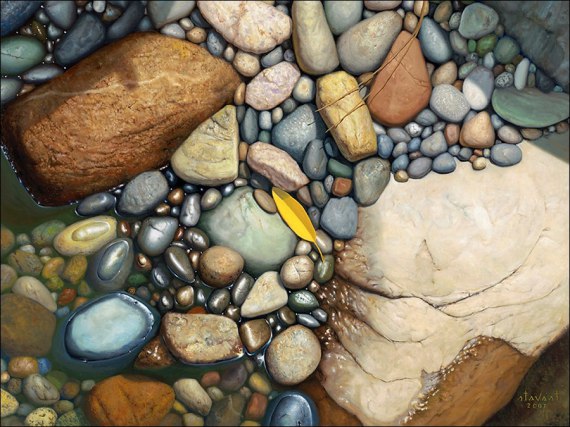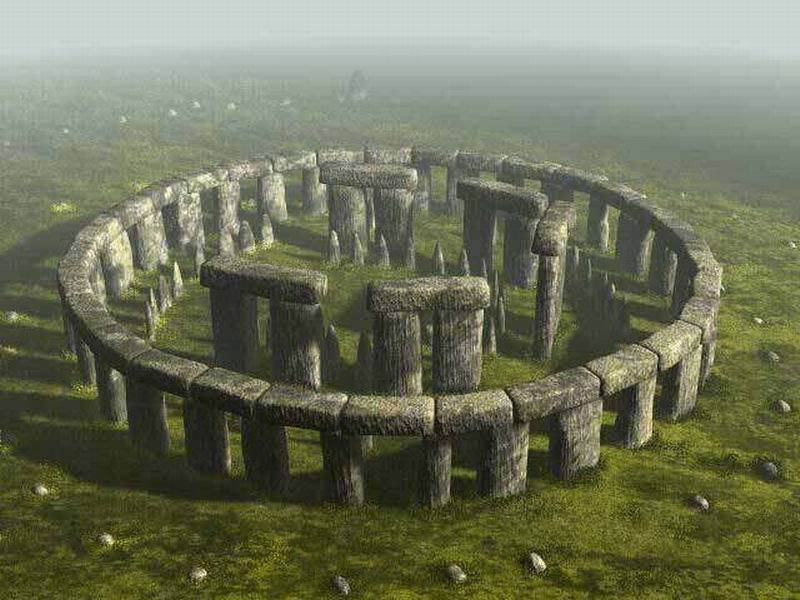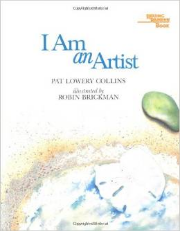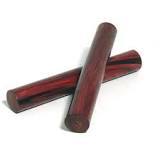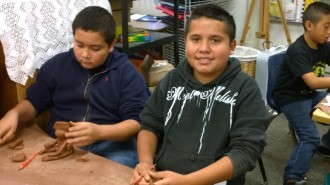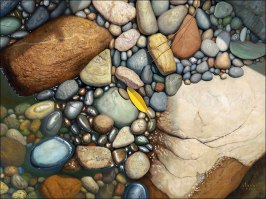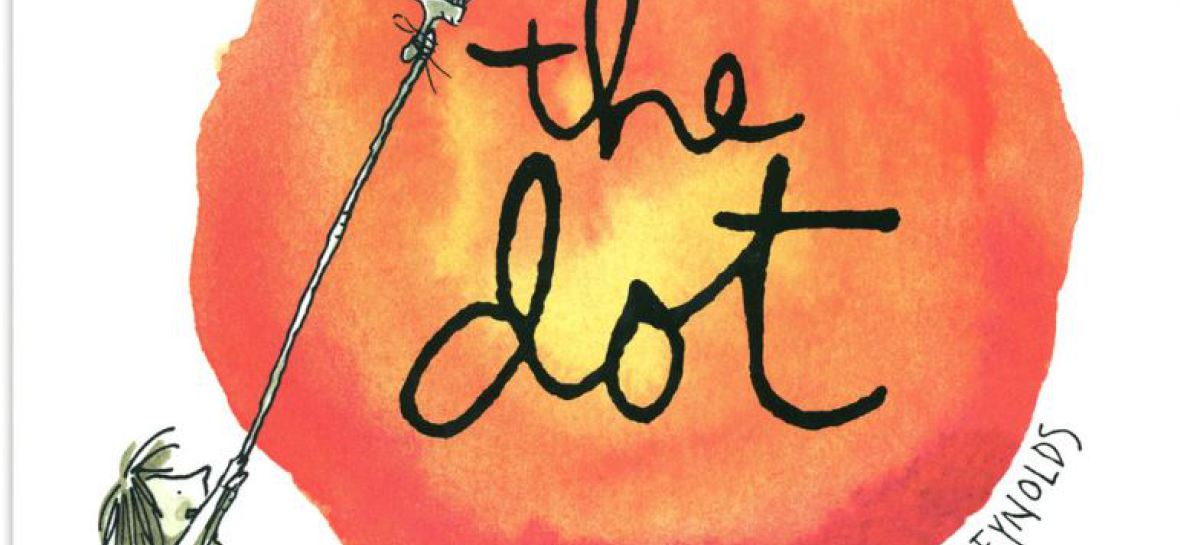

- I am an Artist; Arranging Stones
- Nature of Line Painting with Water
- I am Line; Drawing in Sand
- Oh, to be a Dog!
- The Cat's Pajamas
- Artists in School:Arranging Flowers
- Artists at Home
- Down on the Farm
- Pumpkin Patch Fun
- Leaf Printing
- Owl Babies
- Thanksgiving
- Gingerbread man
- Snowy Day
- Shadows
- Imagine a Miro
- Paint the Sky
- Spring has Sprung
- Blossoms and Bees
- The Hatching
- Snail Spells & Spirals
Kindergarteners view art works created by stone, and then create their own.
Arranging Stones 1.pdf
Adobe Acrobat document [543.1 KB]
I am an Artist
Arranging Stones
I always think art is like magic. The art work by a local artist Stephen Stavast is definately magical. Don't you want to just pick up one of those stones? I sure do. I also want to take my shoes off and walk in the cool forest creek and look for more amazing stones! "What do you see? what do you think? what do you wonder? What Makes You Say That? (Visual Thinking) If you were here inside this painting, what else might you see, smell, hear, taste, and touch? Where do you think the artist was WHEN HE PAINTED THIS? (Above, Below, to the Side) Did he arrange his stones, or did he paint them exactly as he found them?
See Think Wonder A routine for exploring works of art and other interesting things. (n.d.). Retrieved July 15, 2016, from http://www.visiblethinkingpz.org/Free to use: Creative Commons Attribution-NonCommercial 4.0 International License
Into The lesson:
Essential Question: How do artists use their senses to experience art and make art?
Kindergarteners enter the artists' cafe quietly and calmly and sit down on the carpet close to me where we can look at works of art, have discussions, and share stories. For this lesson I have two beautiful art works: "River Rocks" by Stephen Stavast , (a local Oakhurst, CA artist) and an image of "Stonehenge." We then talk about what we see, think, and wonder. I share the story, "I am an Artist." by Pat Lowery and illustrated by Robin Brickman. We talk about the story and how we can use all of our senses to be true artists.
Through The Lesson:
I invite the students to go to their tables and slowly look at
and touch the rocks and carefully sort/group similar stones together. I walk around the tables and ask about
their sorting decisions.
Maybe artist Stavast, painted the river rocks exactly as they were or maybe he arranged them. Do you
think Stonehenge occurred naturally or did humans place them? I have students compose their stones in a beautiful way 3 to 5 times. Then I ask them to arrange them one last time to make their best
composition to exhibit during our "walk about." As I walk around the room, I ask them to think of a title/name for their art work, and explain how they chose their title. I write their words
down on labels that have their pre-printed names. I also take
pictures of their compositions.
I have students "arrange," their stones at least 3 times to teach them art is as fluid and changing
as the river the stones came from. Ideas/art don't have to be "set in stone."
Beyond the Lesson
We re-gather on the carpet in front of the 2 art works and we discuss these questions:
How does using our senses help us create and enjoy art?
Did Stephen Stavist paint the river rocks exactly as he found them or did he arrange them?
Did Stonehenge happen naturally or were they arranged?
Can stones be art just lying on the ground?
What is nature? IS it art?
The following week they can view their portfolio and reflect about what they did with the stones and how they felt. The image of their composition affords them the opportunity to recreate or revise their work as well as draw it.
Assessment
I followed all the directions for this assignment.
I was respectful, responsible, and safe. I shared with my team and with my class. I thought about my decisions as I was making them and shared my ideas and art.
|
yes I Did! |
I Mostly Did |
I Did a Little |
Not Yet But I will |
|
4 |
3 |
2 |
1 |
|
|
|
|
|
I got really lucky in finding felt for sale at a fabric store that was going out of business. I got enough to create table-top
coverings in black. Table-top coverings have three benefits: 1. Decreases the noise level in the room. 2. It gives students another texture to feel. 3. Provides a dramatic backdrop for their stone creations lending it to creating an ambiance of a museum.
When we get done, I create a serpentine snake line of students who follow me around the tables to view the work. We call this our "Walk About." I am always playing music, but change it to create a different mood by using claves to tap out rhythms. Later I shift this responsibility to a student. After we view the work, I ask them to share a thought about someone else's work. I use sentence starters that increase in complexity throughout the year. This is one way to get kids to use the language of art to talk about the art, build classroom community, as well as let kids ask questions of each other. When the children share how they did something really well, it's empowering. The teacher isn't the only one to teach.
I really encourage you, the teacher, to go out yourself and find natural materials. You can take the children with you, but we all need quiet time where we connect with the earth and renew our sense of wonder and magic. I'm blessed to live in the countryside and close to the beautiful Kings River.
Music Selection:
My favorite is
Faces of the Forest 2 by David Lanz & Paul Speer CD, "Natural States"
But we can go to youtube for free! I really try hard to make the art experience awe inspiring and full of wonder.
Using natural materials/stones to create original work of art. Learning Composition
I am an Artist Arranging Stones.pdf
Adobe Acrobat document [634.5 KB]
Including Parents and Adding Poetry
PL1Stepping over stepping stones.pdf
Adobe Acrobat document [309.9 KB]
Artful Teaching
Mrs. Schellenberg & Young Artists
Ralph Waldo Emerson's Poem: Success- to leave the world a bit better, whether by a healthy child, a garden patch or a redeemed social condition; To know even one life breathed easier because of you.
Thank you AT&T
We used the wiring for our artful galimotos

